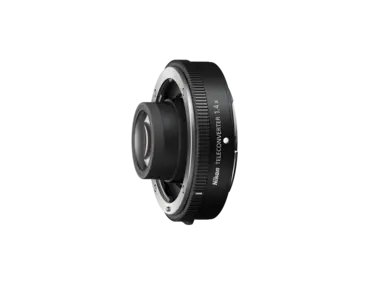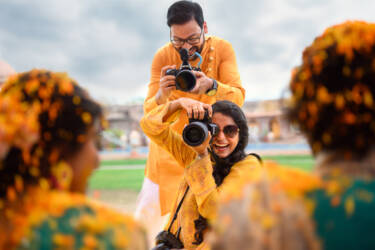The quick guide to using teleconverters

This small piece of kit can double your lens collection in an instant – Dom Salmon provides the lowdown on teleconverters
Teleconverters, or TCs, are a kind of optical cheat code, which means you can have two lenses in one, effectively adding a lot of extra focal reach to an existing lens. As a creative director and photographer, I’m a big fan, so let me make the case for their very particular photo and video superpower.
A TC is a neat optical device that comes between your camera body and your lens. Nikon’s teleconverters, the Z TC-2.0x and Z TC-1.4x (which are the multiples of focal length each gives you), work with zooms and primes. No mechanics, no wasting time – just put it on your camera body, attach the lens and… bingo! With a 2.0x converter, your lens now has twice the focal length. So, couple that with your NIKKOR Z 70-200mm f/2.8 VR S zoom and you’ve just got a very novel 140-400mm. Sweet.
Nikon Z 9 with NIKKOR Z 800mm f/6.3 VR S
With teleconverter TC-2.0x
A free lunch lens?
Teleconverters are great for several reasons. First up is the totally different focal length from the same lens. That means you have twice the compositional options from the same piece of kit. It’s handier than you might think, especially in a wildlife (teleconverters love going on safari!) or sports situation, and even in portrait shoots. If it all feels a bit flat or dull, try taking a standard 85mm length and turbocharging it to 170mm. It gives a very different look and feel indeed.
The TC’s addition of weight is pretty negligible. If you’ve ever tried wielding a 600mm lens, you might feel as if you need a few protein shakes after about 20 minutes – but a 300mm and a 2x converter is nowhere near that heavy or bulky.
Then there’s a cost factor. That 600mm lens can be pretty expensive, but a ‘cheated’ 300mm not so much. Plus, don’t forget that you’ve effectively got two lenses. It’s quite the bargain in comparison.
Nikon Z 9 with NIKKOR Z 800mm f/6.3 VR S
With teleconverter TC-1.4x
What’s the catch?
Too good to be true? As in life, there are some trade-offs, which is why teleconverters have faced criticism in the past when compared to a ‘real’ 600mm, for example.
First up, and most obvious, is that the addition of this extra stage into the light path reduces a lens’ maximum aperture. The reason converters are in 1.4x and 2x formats is because you end up with a one stop loss with a 1.4x converter, and two stops for the 2x.
There’s also the fact that a teleconverter works by magnifying the image it receives from the lens itself before it hits the sensor. This can mean that you lose any vignetting (a circular darkening around the frame’s edge) an old lens might have (good news), but it does mean things like chromatic aberration (also known as odd-looking colours), or distortion, in the lens may be magnified and so more prevalent in your image or movie. As we’ll see, however, this is much less of a problem with the latest lens technology.
Lastly, teleconverters don’t work with wide-angle lenses. There’s simply not enough room between the back element of the lens and the camera’s sensor to accommodate the teleconverter and its distinct ‘barrel’ protrusion.
So, what?
Once those things were a big deal, but they are much less relevant today, and day-to-day maybe not at all.
Optical technology and manufacture are so much more advanced, especially on Nikon Z mount lenses. There are far fewer imperfections in even non-professional lenses for your converter to magnify. And the teleconverter technology is now so good that lenses are starting to appear with a TC built in. The NIKKOR Z 400mm f/2.8 TC VR S and NIKKOR Z 600mm f/4 TC VR S are a dream for pro wildlife and sports shooters, with a TC-1.4x available on both at the simple flick of a switch. Using a 2.0x teleconverter with the new NIKKOR Z 70-180mm f/2.8 lens allows you to go to 360mm and doubles the reproduction ratio of the lens to an almost life-size 0.96 magnification – perfect for macro photography.
With AF being so fast, even in demanding sports shoots you’ll still get a lots of fabulous shots. Basketball in a darkish sports hall might push your AF to the limit but, don’t forget, without that converter you wouldn’t even have those new camera angles to work with.
In some ways, the key factor in using a teleconverter is to up your long-lens game. There is a huge difference in how you handle a lens at 300mm and at 600mm. Even with in-body and in-lens VR stabilisation, you should be thinking about faster shutter speeds to freeze action and eliminate shake. Yes, that’s tougher with less light through that smaller aperture, but don’t forget to lean into a faster ISO to compensate. I love the full-frame Z series sensors in low light, and you can get away with increasing ISO and still have pretty finely grained images at 1000 and up. And if you don’t already, shoot in RAW, as there’s still plenty of detail to recover from those shadows in your edit if you’re exposing a little ‘to the left’ (i.e. underexposing by a stop or so) on your shoot.

I need you just a little longer
Talking of technical, I do hear a lot of people say, especially in videography, “Well with today’s higher resolutions, why don’t you just crop in later, it’s kind of the same thing the converter’s doing.” True, in a sense, but, personally, I just don’t get that. You frame shots and react to the movement and action in front of you completely differently when you are using the viewfinder or LCD screen. Trying to think what the middle 50% of your frame would be like just feels like guesswork. Plus, you are sacrificing image quality in another way, so it’s a trade-off I don’t see any value in.
So, give teleconverters a chance! If you know their limitations and plan accordingly, they can be a revelation. Just think, by adding one to your bag, you’ve doubled a lot of your lens choices, added only a couple of hundred grams to your kit and spent a fraction of what one extra lens would cost.
Imagine if you were on safari and came across a pride of lions, but your 300mm wasn’t quite cutting it for that killer shot. Well, you could get out of the Jeep and try to get a lot closer, but I wouldn’t recommend it…
More in Tips and Tricks
Featured Products
Discover the NIKKOR Z 70-180mm f/2.8

For limitless creativity










